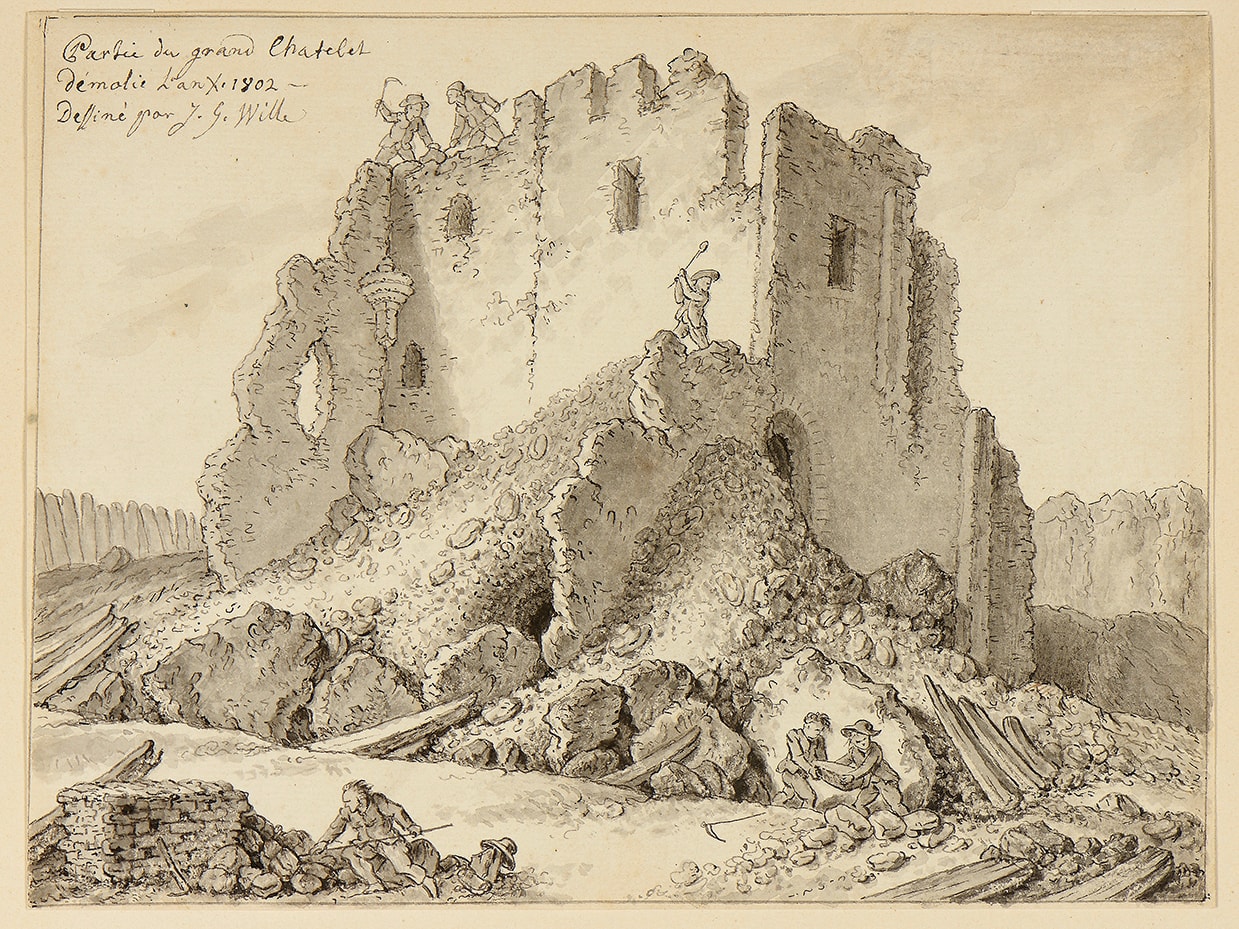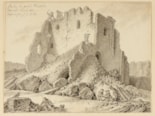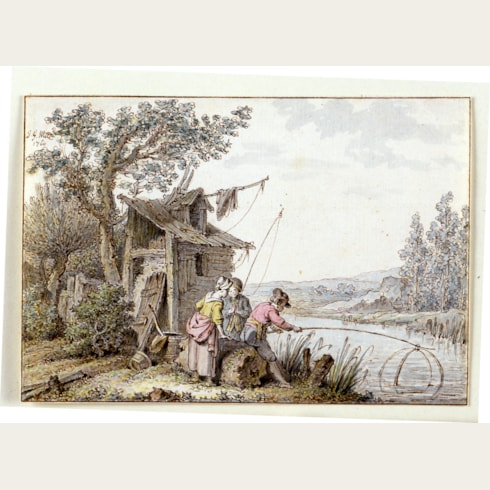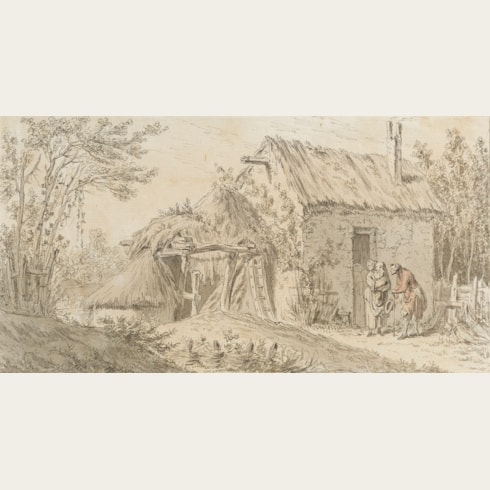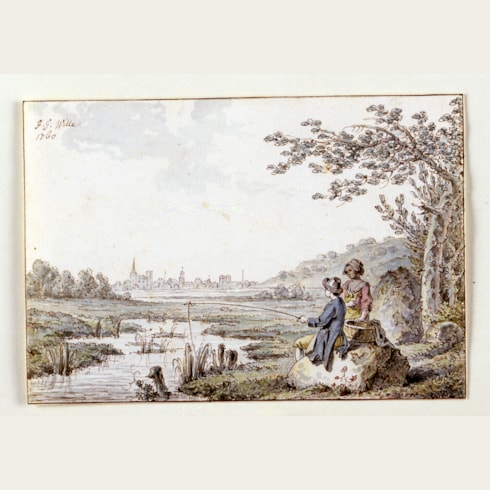Jean-Georges WILLE
(Biebertal 1715 - Paris 1808)
The Demolition of the Grand Châtelet, Paris
Sold
Pen and black ink and grey wash, with framing lines in black ink.
Signed, dated and inscribed Partie du grand Chatelet/ démolie l’an X. 1802 - / Dessiné par J.G. Wille at the upper left.
Stamped 0183 in black ink on the verso.
185 x 247 mm. (7 1/4 x 9 3/4 in.)
Signed, dated and inscribed Partie du grand Chatelet/ démolie l’an X. 1802 - / Dessiné par J.G. Wille at the upper left.
Stamped 0183 in black ink on the verso.
185 x 247 mm. (7 1/4 x 9 3/4 in.)
Wille’s oeuvre of drawings includes over a hundred landscapes, most of which are signed and dated, notably several studies of ruined buildings and châteaux. As Emmanuelle Brugerolles has noted of the artist, ‘The fascination with the ruins of monuments of national history dates back to the 1760s and was partly inspired by Italianate Dutch artists of the 17th century, notably Jacob van Ruisdael or especially Laurens Vincentsz. van der Vinne...If Wille is looking for an objective description of the motif in his first drawings [of the 1760s]...he seems more sensitive in the 1770s to the degradation caused by time and nature on medieval buildings.’
A late drawing by Wille, the present sheet depicts the early stages of the demolition of the Ancien Régime fortress and prison known as the Grand Châtelet in Paris, located on the right bank of the river Seine. Built by Louis VI in 1130, the châtelet (or ‘small castle’) initially served to defend a bridge over the river. By the early 13th century the Grand Châtelet was the headquarters and court of the prévôt de Paris, or Provost of Paris; a royal officer charged with maintaining royal justice. The Grand Châtelet was completely rebuilt in 1684 and continued to serve as both a municipal prison and courthouse until the abolition of the position of the prévôt de Parisin 1790, during the Revolution. The imposing Grand Châtelet was demolished between 1802 and 1810, and the area was rebuilt as the modern Place du Châtelet.
Among Wille’s drawings of a similar technique and subject, though several years earlier in date, is The Ruins of the Château of Monfort-l’Amaury, dated 1779, in the Schlossmuseum in Weimar.
A late drawing by Wille, the present sheet depicts the early stages of the demolition of the Ancien Régime fortress and prison known as the Grand Châtelet in Paris, located on the right bank of the river Seine. Built by Louis VI in 1130, the châtelet (or ‘small castle’) initially served to defend a bridge over the river. By the early 13th century the Grand Châtelet was the headquarters and court of the prévôt de Paris, or Provost of Paris; a royal officer charged with maintaining royal justice. The Grand Châtelet was completely rebuilt in 1684 and continued to serve as both a municipal prison and courthouse until the abolition of the position of the prévôt de Parisin 1790, during the Revolution. The imposing Grand Châtelet was demolished between 1802 and 1810, and the area was rebuilt as the modern Place du Châtelet.
Among Wille’s drawings of a similar technique and subject, though several years earlier in date, is The Ruins of the Château of Monfort-l’Amaury, dated 1779, in the Schlossmuseum in Weimar.
Born in the German province of Hesse, Johann Georg Wille arrived in Paris at the age of twenty-one, and soon established a reputation as an engraver. Although much of his early work in the 1740’s was in the form of portrait engravings after such artists as Hyacinthe Rigaud and Louis Tocqué, by the early 1750’s he had also begun producing prints of genre subjects, mainly after the work of contemporary German and Dutch artists. Known in France as Jean-Georges Wille, he had by 1755 gained French citizenship and membership in the Académie Royale. Appointed an Academician in 1761, Wille stopped producing portrait engravings soon afterward, his failing eyesight not allowing him to work on portraits with his usual meticulous technique.
As 'graveur du roi' and also engraver to the King of Denmark and the Emperor of Germany, Wille’s reputation reached its peak in the years before the French Revolution. His studio in Paris was a centre of printmaking and a meeting place for artists, collectors and dealers, and he was himself active in the art trade. He was also particularly influential among the younger generation of German and Swiss artists; among his pupils were Adrian Zingg, Jakob Matthias Shmutzer and Ferdinand Kobell.
Wille’s reputation declined after the Revolution, however, and near blindness meant that he produced little in the final years of his career, with his last dated engraving executed in 1790. Active throughout his career as a collector and dealer, Wille owned a large number of paintings and drawings by French, Dutch and German artists, several of which he reproduced as engravings. His memoirs and journal, an important source of information about the Parisian art world of the 18th century, were published posthumously in 1857.

